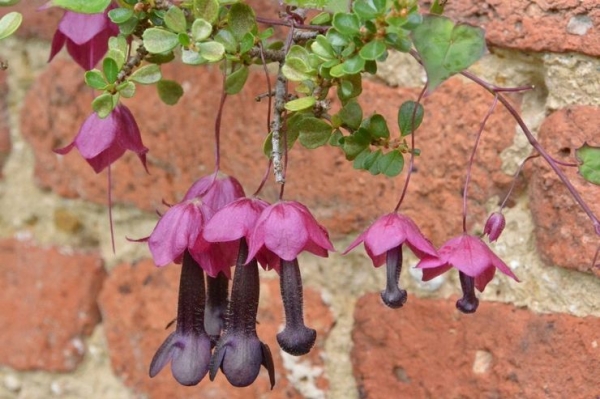
Rhodochiton (Rhodochiton) is a perennial vine, the shoots of which are notable for rapid growth. The main advantage of plants is impressive inflorescence. Flower rhodochiton suitable for cultivation in home conditions and can grow outdoors in the garden.
1 Description of rhodochiton 2 Growing from seed rhodochiton 2.1 2.2 Timing of planting How to plant seeds 2.3 How to care for seedlings Transplant to the garden 2.4 plot 2.5 Conducting grafting 3 Care rhodochiton at home and outdoors Lighting 3.1 3.2 3.3 Mode of irrigation the moisture Level of 3.4 Soil 3.5 Feeding 3.6 Rule 3.7 crop Wintering 4 pests and Diseases 5 Rhodochiton in landscape design
Description of rhodochiton
Rhodochiton refers to Nalichnimi plant plants. The spread of perennial in nature is concentrated in Mexico and Central America. Climbing stems need to install supports. As a rule, the culture was planted next to fences or trees. The length of adult specimens is up to 4 m. the Intense sunlight makes the leaves crimson. Form of heart-shaped leaves in the middle are the strings of pale reddish veins.
Rhodochiton stands out from other garden landscapers primarily beautiful flowers, which have a dizzying aroma. Inflorescences are under every leaf and stick on the stems with elongated peduncles. The approximate size of a tubular calyx 25 mm. It is formed of five petals. The Bud head has the shape of a bell. Blooming blossoms painted in Burgundy color, like grape wine. In the center of the cups stick out fragile stamens and the petals layer covers the delicate cloth. Five-pointed perianth bell looks a tone lighter than the whole flower. The upper part pointed. The withering away of the perianth occurs only after the vine will wither. The flowering phase of rhodochiton starts in summer and lasts three months.
Grow rhodochiton either in the apartment or in the garden. In regions dominated by temperate climate, outdoor winter norinally the representative is unlikely to survive even in the presence of high-quality shelter. In the garden rhodochiton grow as annual. As soon as cold, a pot with a shrub is to move indoors, where the plant will survive the winter until spring. In countries with warm climate rhodochiton not threatened by freezing, so the vine is allowed to grow in the open ground.
If you do not care for the flower, over time, the vine will lose its spectacular appearance. At least 1 time in five years the Bush update.
Growing rhodochiton from seed
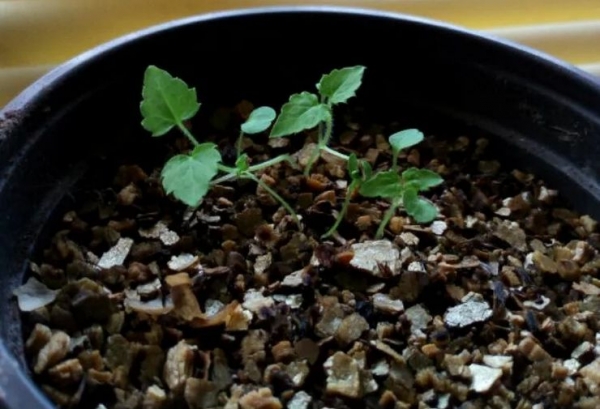
Sowing
The time interval of immersion of the seeds in the soil depends on the climatic conditions of the area. Seeds rhodochiton grown to decorate the walls and arbors, can be sown in any weather. From February to March is the sowing of seeds in that case, if the seedlings are then planning to replant on the site.
How to plant seeds
For growing seedlings of rhodochiton take a wooden box. Inside fill friable substrate, which should consist of 1 proportion of garden soil, 1 share of humus and 1 share of coarse sand.
Pre-treated seeds margantsovokislym solution for 5-10 min. then they are washed with water and spread on the surface of moist soil. To evenly distribute the seeds in a box, better get a toothpick. Top seeds lightly tamped and sprinkled with sand or remaining substrate. Throughout the stage of germination the crops are sprayed with water in moderate amounts. Excess moisture causes mold and mildew in cultivated containers.
Instead of drawers often use a special case where one planted the seed. This method allows you to save time on swordplay and to protect seedlings from root injuries. Seedlings transplanted to a new pot, for a long time to adapt. To finally settle down, some of them will require 1.5 months. In this period, the bushes look weak and often sick.
To create greenhouse conditions crop tank covered with glass or piece of film. It is important to ensure the seedlings room temperature of about 20-24 degrees. To store boxes in the room where it's too cold, is highly undesirable. Seedlings under similar conditions seem slower. Crops regularly open to get rid of condensation that has accumulated under the film.
How to care for seedlings
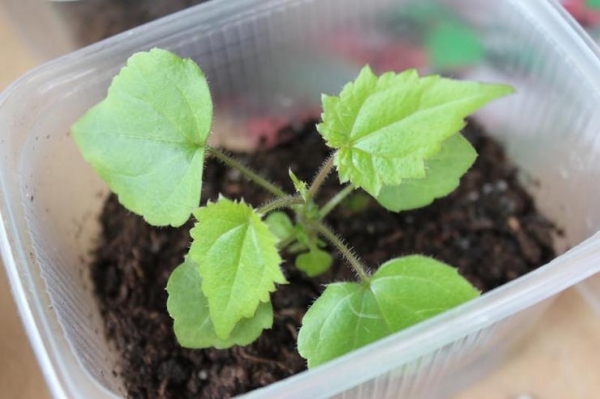
The top of the first sprouts appear on the 2nd or 3rd week. Then boxes with moving crops to the veranda with temperatures of 16-18 degrees, the plants well hardened before shipment to a garden plot. Due to the low temperature, the sprouts are not stretched.
When the shoots get stronger, with the boxes shoot the film. To the seedlings easily adapt in a new place, they are systematically aired. The tank should stand away from direct sunlight, however, have access to natural lighting source. In case of contact with scorching rays on young leaves remain burns.
Dive seedlings after the formation of 3 healthy leaf blades. The procedure is performed in individual cassettes or compact pots, diameter not exceeding 10cm and a height of 8 cm.
Transplanted seedlings take root in 1-2 weeks. All this time, they grow poorly and look sickly. Once the adaptation process is complete, the culture will again begin to increase mass. To the seedlings easily undergo the pick, move containers away from direct sun. The best option is placement in partial shade. Raspolirovki shrubs watered in moderate amounts. Stagnant soil water entails rotting of the roots.
When the seedlings gain strength, capacity, again are entered into the lighted room and maintain the same regime of irrigation. The length of the light day should be longer. If there is insufficient light, you need to install supplementary lighting. As lighting use fitolampy. If the bushes will miss the light, the sprouts will rush up. Seedlings are best stored near the window openings, which are directed to the East or West.
Seedlings of rhodochiton with a greatly expanded root system are transplanted to a larger pot. The plant will not thrive too close to the pot.
Transplant to the garden plot
In may or June grown clumps are transferred to a permanent habitat. Before that they harden from day to day. Leave the pots outdoors for some time that the future of Liana had become accustomed to the environment.
Perekopa plot for seedlings, make a shallow hole that is filled with water. When the earth absorbs the moisture, the seedlings are transferred transit method, keeping the soil ball to avoid damage to weak roots. Between the holes maintaining a safe distance.
Holding cuttings
During the spring and autumn period, rhodochiton propagation method of grafting. The pots are filled with nutritive substrate and placed inside pieces of the shoots. To start rooting and to create a favorable microclimate, shanks covered with half a plastic bottle or a package.
Until the cuttings are rooted, they systematically ventilate. When cuts have rooted, rhodochiton is deposited into the pot of a larger size. If you wish subsequently the vine can be planted on the site. The cuttings planted in the autumn, is transferred to the outside only with the arrival of spring warmth.
Care rhodochiton at home and outdoors
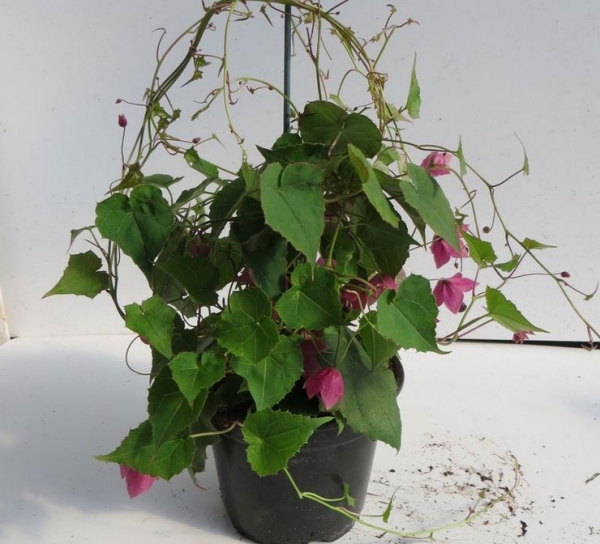
Lighting
For lush and abundant flowering rhodochiton you need good lighting. Allowed to grow perennial in partial shade, for example, next to the fence or under the canopy of trees. Also vine shoots develop normally climbing the walls of the house or gazebo.
Bright South rooms, it is preferable to place the flower pot away from the window opening. Sills, located on the West or East side, is considered the most optimal place for growing rhodochiton.
Watering
The soil filled flower pot, soil is kept moist. Should not be allowed to water for a long time stagnated at the bottom of the pot. In the summer there is a drought and no rain, the shrubs watered as often as possible.
The humidity level
Rhodochiton in the home need in the humid air. Due to heated appliances in confined areas there is often a lack of oxygen. The leaves of the flower are regularly sprayed with water to defend with the spray. Some florists is installed next to the pot is a container filled with water, or purchase a humidifier – a device that regulates humidity in the conditions of insufficient air conditioning.
Soil
Transplant rhodochiton carried out in fertile and loose soil, which has high permeability. At the bottom of planting holes, it is recommended to pour the humus below the bushes long enough nutrients.
Feeding
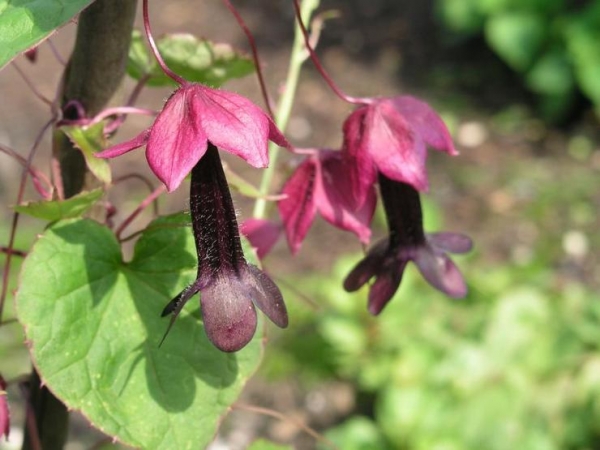
Entire growing period of the vine fed 2 times per month. Used mineral mixture. The culture is sick, if a lack of phosphorus in the tissues.
The rules of trimming
With the aim of preserving a spectacular crown shoots are constantly cut. Activities performed in the spring before flowering or in the fall before the plant goes to dormant stage. The third part of the stem is cut. The obtained segments used for breeding.
Important! A prerequisite for the cultivation of rhodochiton is to install the support. If the shoots are not something to cling to, under the weight of the leaves, the bushes will soon break.
Wintering
Rhodochiton able to overwinter only room where the temperature does not drop below the level of +16 degrees. In the dormant period provide scant watering. If daylight is less than 14 hours, use the fitolamp.
Diseases and pests
As a result of low humidity, the tops of the leaves will dry out over time. The bushes are infected with mildew. Vegetative parts with signs of disease are removed. Planting sprayed with fungicidal solution.
Harm to the causes rhodochiton well as aphids and whiteflies. Diseased aphids the leaves are covered with sticky dew. The deformation of the sheet and wilting buds. Colony pest attack of juicy green part of perennial. To cope with the scourge help chemicals – insecticides. The greenery attracts slugs. Bring slugs from the garden is possible only manually. Bushes inspect from all sides, collect insects in a jar and then destroy.
Rhodochiton in landscape design
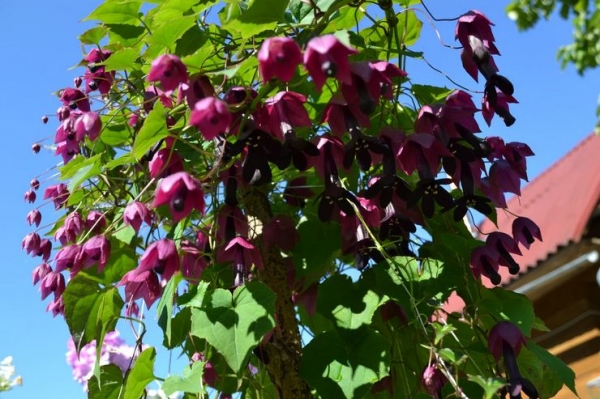
In landscape design use rhodochiton dark blood – evergreen plant with twining shoots, which in the wild the species is found in Mexico and Central America. Acuminate leaves, painted in a dark green, contrasting with the tubular scarlet flowers. When the blossoms fall off, the stalks remain on the seed pods.
Planting rhodochiton groups of a few bushes, gardeners get thick and lush undergrowth, which perfectly fill the extra area on the site. Vines are near fences, walls and fruit trees. The plant quickly coexist with different cultures. Rhodochiton flowers are the perfect decoration for any gazebo or loggia.
In the middle climatic zones florists recommend planting a perennial in pots or planters. In the fall of containers is brought to the house so that the stems are not frozen. While the plant is dormant, the vine it is advisable to keep in the cool, for example, in the winter garden or gazebo. As a decor element flower grown in pots placed on windowsills or on shelves.
Proper planting of cedar seedlings in the garden
